International Marketing Strategies and Market Entry Report
VerifiedAdded on 2022/12/26
|9
|2673
|39
Report
AI Summary
This report provides a comprehensive analysis of international marketing strategies, using the Coca-Cola company as a case study. It begins by defining international marketing and its scope, emphasizing the global village concept and the importance of adapting products and services to meet diverse consumer needs. The report then explores the rationale for companies like Coca-Cola to expand internationally, including building brand recognition and catering to evolving consumer demands. It details various market entry routes such as establishing branches, licensing arrangements, franchising, joint ventures, and strategic alliances, highlighting the advantages and disadvantages of each. Furthermore, the report evaluates key criteria for international market selection, including objectives, parameters, preliminary screening, and test marketing. Finally, it explains different marketing strategies, such as exporting, licensing, and acquiring existing companies, with examples and an analysis of their respective advantages and disadvantages. This report aims to provide insights into the complexities and nuances of international marketing and strategic decision-making.
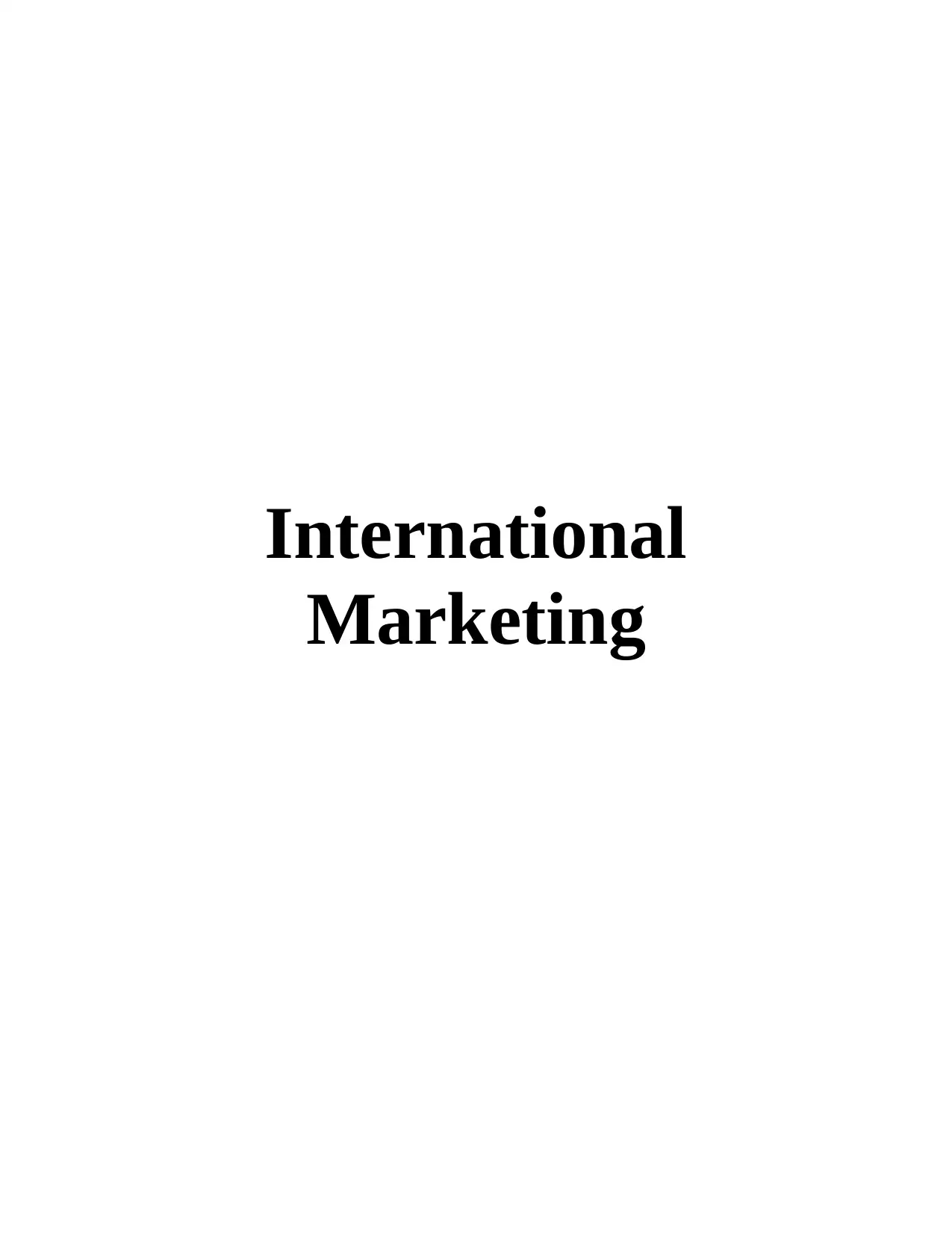
International
Marketing
Marketing
Paraphrase This Document
Need a fresh take? Get an instant paraphrase of this document with our AI Paraphraser
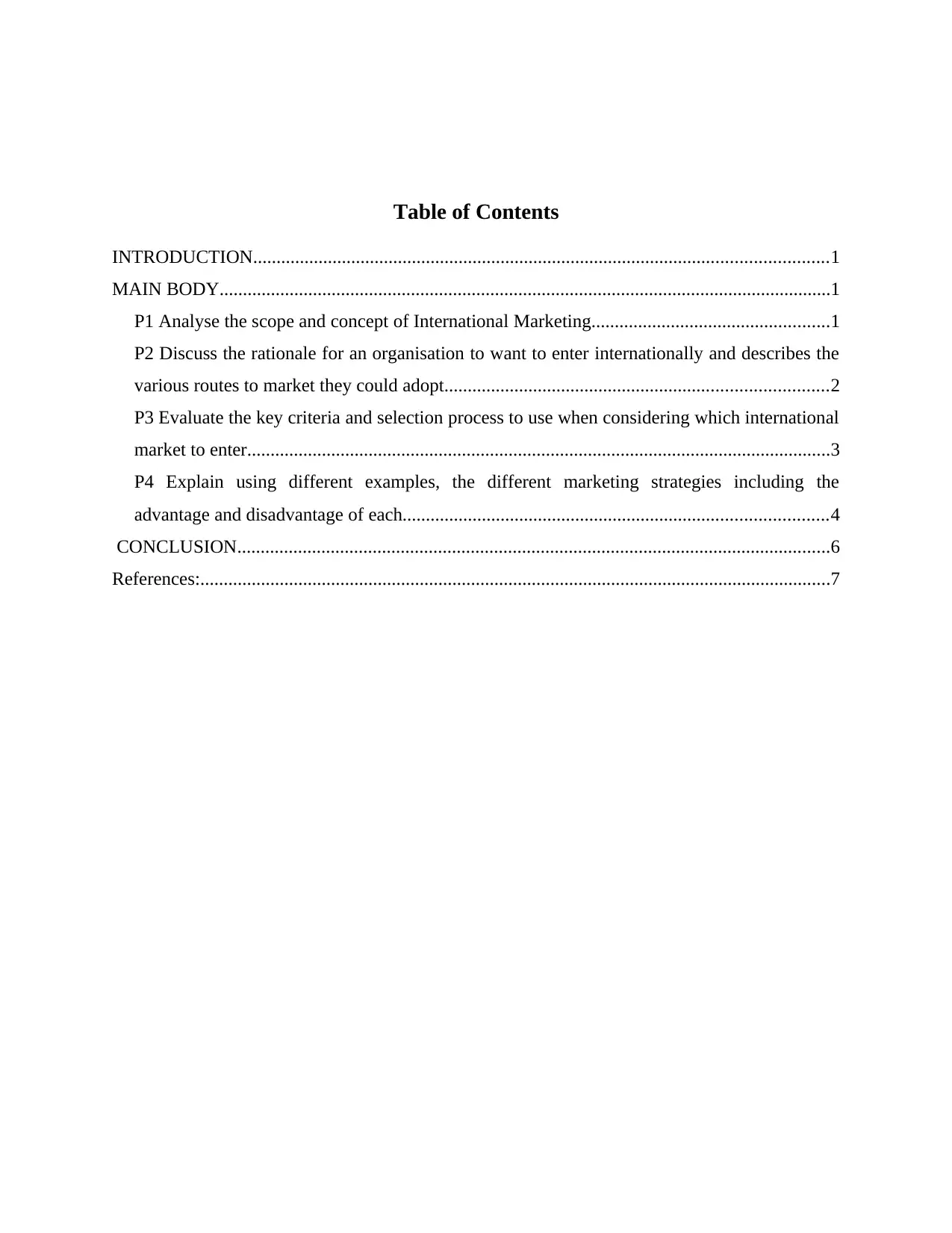
Table of Contents
INTRODUCTION...........................................................................................................................1
MAIN BODY...................................................................................................................................1
P1 Analyse the scope and concept of International Marketing...................................................1
P2 Discuss the rationale for an organisation to want to enter internationally and describes the
various routes to market they could adopt..................................................................................2
P3 Evaluate the key criteria and selection process to use when considering which international
market to enter.............................................................................................................................3
P4 Explain using different examples, the different marketing strategies including the
advantage and disadvantage of each...........................................................................................4
CONCLUSION...............................................................................................................................6
References:.......................................................................................................................................7
INTRODUCTION...........................................................................................................................1
MAIN BODY...................................................................................................................................1
P1 Analyse the scope and concept of International Marketing...................................................1
P2 Discuss the rationale for an organisation to want to enter internationally and describes the
various routes to market they could adopt..................................................................................2
P3 Evaluate the key criteria and selection process to use when considering which international
market to enter.............................................................................................................................3
P4 Explain using different examples, the different marketing strategies including the
advantage and disadvantage of each...........................................................................................4
CONCLUSION...............................................................................................................................6
References:.......................................................................................................................................7
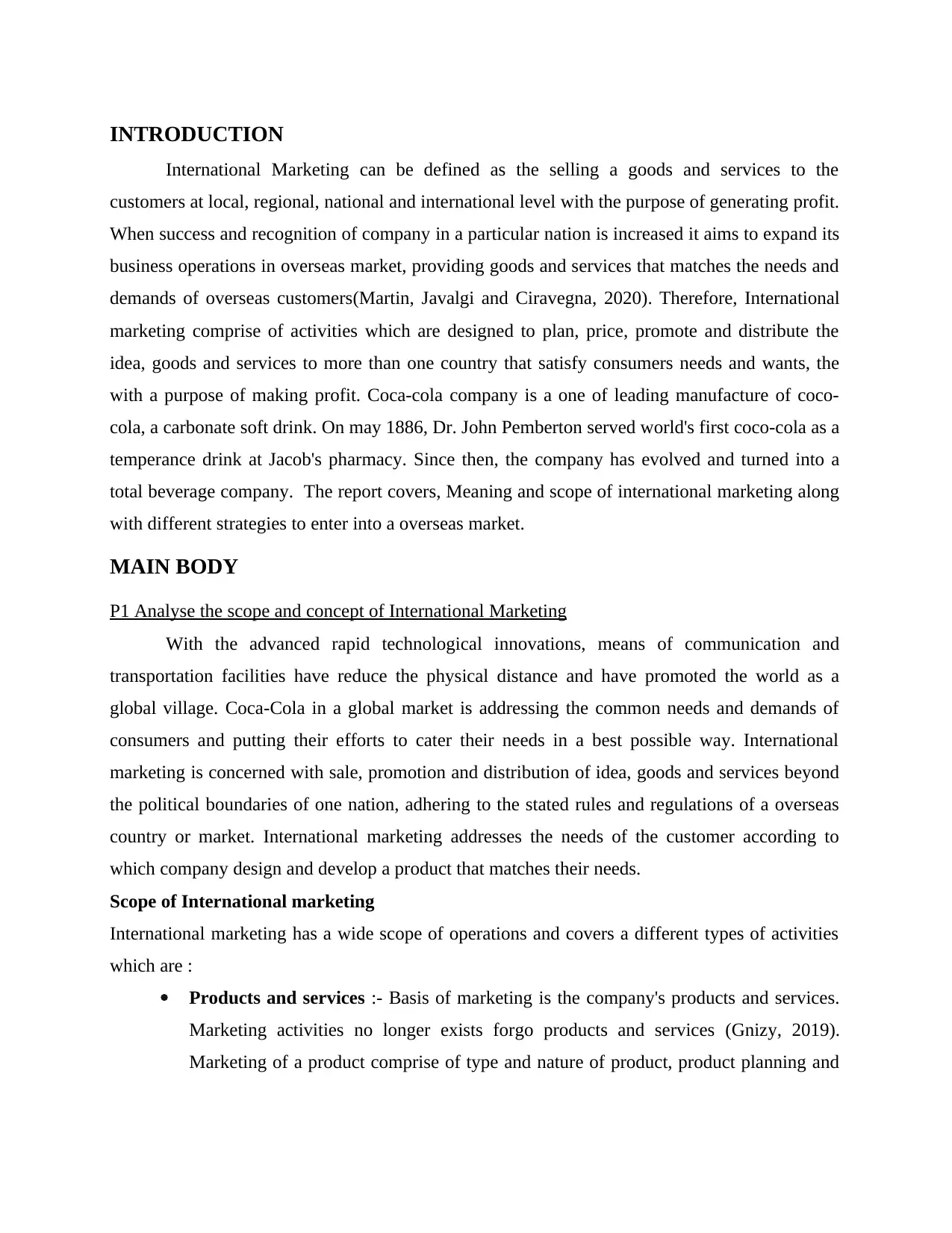
INTRODUCTION
International Marketing can be defined as the selling a goods and services to the
customers at local, regional, national and international level with the purpose of generating profit.
When success and recognition of company in a particular nation is increased it aims to expand its
business operations in overseas market, providing goods and services that matches the needs and
demands of overseas customers(Martin, Javalgi and Ciravegna, 2020). Therefore, International
marketing comprise of activities which are designed to plan, price, promote and distribute the
idea, goods and services to more than one country that satisfy consumers needs and wants, the
with a purpose of making profit. Coca-cola company is a one of leading manufacture of coco-
cola, a carbonate soft drink. On may 1886, Dr. John Pemberton served world's first coco-cola as a
temperance drink at Jacob's pharmacy. Since then, the company has evolved and turned into a
total beverage company. The report covers, Meaning and scope of international marketing along
with different strategies to enter into a overseas market.
MAIN BODY
P1 Analyse the scope and concept of International Marketing
With the advanced rapid technological innovations, means of communication and
transportation facilities have reduce the physical distance and have promoted the world as a
global village. Coca-Cola in a global market is addressing the common needs and demands of
consumers and putting their efforts to cater their needs in a best possible way. International
marketing is concerned with sale, promotion and distribution of idea, goods and services beyond
the political boundaries of one nation, adhering to the stated rules and regulations of a overseas
country or market. International marketing addresses the needs of the customer according to
which company design and develop a product that matches their needs.
Scope of International marketing
International marketing has a wide scope of operations and covers a different types of activities
which are :
Products and services :- Basis of marketing is the company's products and services.
Marketing activities no longer exists forgo products and services (Gnizy, 2019).
Marketing of a product comprise of type and nature of product, product planning and
International Marketing can be defined as the selling a goods and services to the
customers at local, regional, national and international level with the purpose of generating profit.
When success and recognition of company in a particular nation is increased it aims to expand its
business operations in overseas market, providing goods and services that matches the needs and
demands of overseas customers(Martin, Javalgi and Ciravegna, 2020). Therefore, International
marketing comprise of activities which are designed to plan, price, promote and distribute the
idea, goods and services to more than one country that satisfy consumers needs and wants, the
with a purpose of making profit. Coca-cola company is a one of leading manufacture of coco-
cola, a carbonate soft drink. On may 1886, Dr. John Pemberton served world's first coco-cola as a
temperance drink at Jacob's pharmacy. Since then, the company has evolved and turned into a
total beverage company. The report covers, Meaning and scope of international marketing along
with different strategies to enter into a overseas market.
MAIN BODY
P1 Analyse the scope and concept of International Marketing
With the advanced rapid technological innovations, means of communication and
transportation facilities have reduce the physical distance and have promoted the world as a
global village. Coca-Cola in a global market is addressing the common needs and demands of
consumers and putting their efforts to cater their needs in a best possible way. International
marketing is concerned with sale, promotion and distribution of idea, goods and services beyond
the political boundaries of one nation, adhering to the stated rules and regulations of a overseas
country or market. International marketing addresses the needs of the customer according to
which company design and develop a product that matches their needs.
Scope of International marketing
International marketing has a wide scope of operations and covers a different types of activities
which are :
Products and services :- Basis of marketing is the company's products and services.
Marketing activities no longer exists forgo products and services (Gnizy, 2019).
Marketing of a product comprise of type and nature of product, product planning and
⊘ This is a preview!⊘
Do you want full access?
Subscribe today to unlock all pages.

Trusted by 1+ million students worldwide
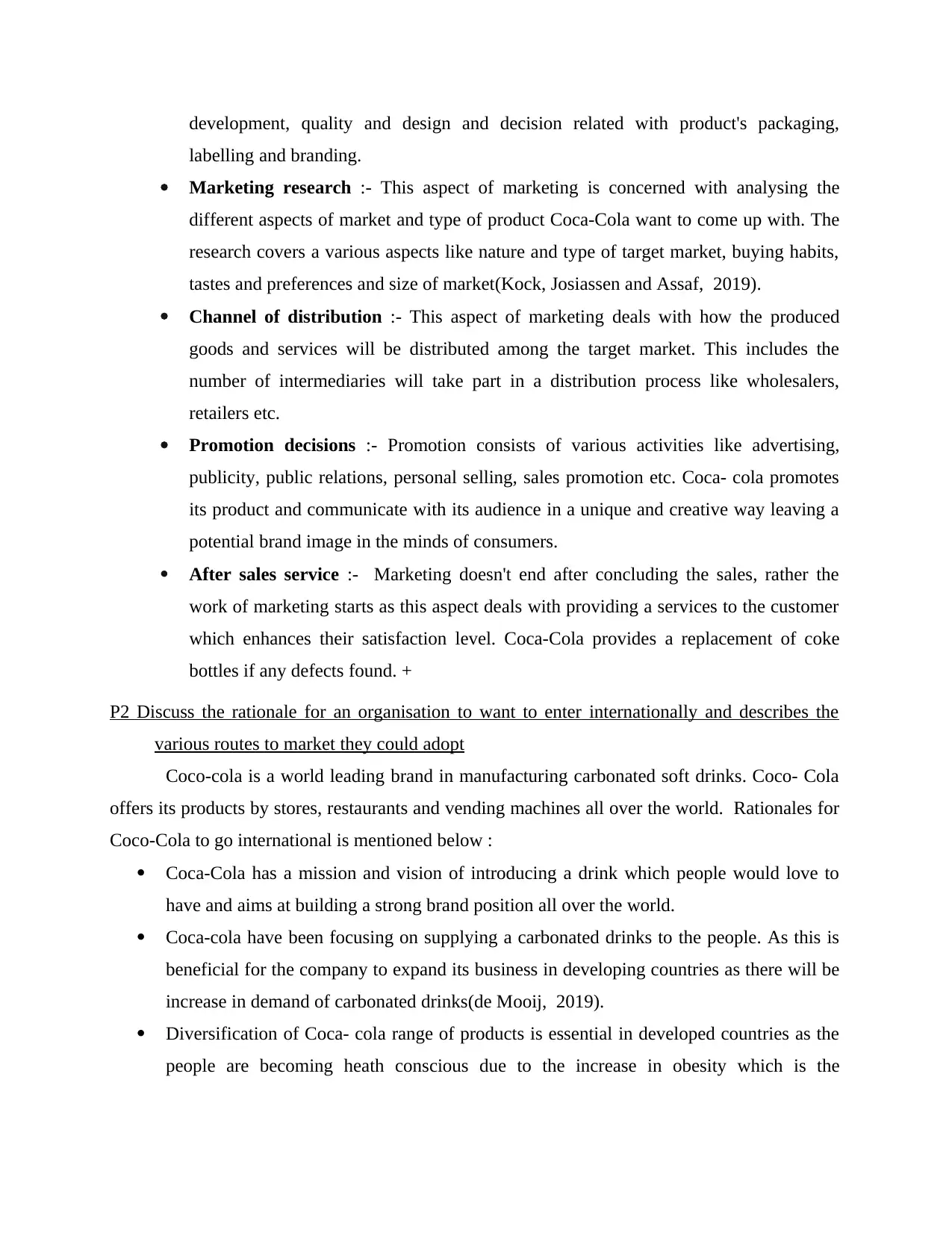
development, quality and design and decision related with product's packaging,
labelling and branding.
Marketing research :- This aspect of marketing is concerned with analysing the
different aspects of market and type of product Coca-Cola want to come up with. The
research covers a various aspects like nature and type of target market, buying habits,
tastes and preferences and size of market(Kock, Josiassen and Assaf, 2019).
Channel of distribution :- This aspect of marketing deals with how the produced
goods and services will be distributed among the target market. This includes the
number of intermediaries will take part in a distribution process like wholesalers,
retailers etc.
Promotion decisions :- Promotion consists of various activities like advertising,
publicity, public relations, personal selling, sales promotion etc. Coca- cola promotes
its product and communicate with its audience in a unique and creative way leaving a
potential brand image in the minds of consumers.
After sales service :- Marketing doesn't end after concluding the sales, rather the
work of marketing starts as this aspect deals with providing a services to the customer
which enhances their satisfaction level. Coca-Cola provides a replacement of coke
bottles if any defects found. +
P2 Discuss the rationale for an organisation to want to enter internationally and describes the
various routes to market they could adopt
Coco-cola is a world leading brand in manufacturing carbonated soft drinks. Coco- Cola
offers its products by stores, restaurants and vending machines all over the world. Rationales for
Coco-Cola to go international is mentioned below :
Coca-Cola has a mission and vision of introducing a drink which people would love to
have and aims at building a strong brand position all over the world.
Coca-cola have been focusing on supplying a carbonated drinks to the people. As this is
beneficial for the company to expand its business in developing countries as there will be
increase in demand of carbonated drinks(de Mooij, 2019).
Diversification of Coca- cola range of products is essential in developed countries as the
people are becoming heath conscious due to the increase in obesity which is the
labelling and branding.
Marketing research :- This aspect of marketing is concerned with analysing the
different aspects of market and type of product Coca-Cola want to come up with. The
research covers a various aspects like nature and type of target market, buying habits,
tastes and preferences and size of market(Kock, Josiassen and Assaf, 2019).
Channel of distribution :- This aspect of marketing deals with how the produced
goods and services will be distributed among the target market. This includes the
number of intermediaries will take part in a distribution process like wholesalers,
retailers etc.
Promotion decisions :- Promotion consists of various activities like advertising,
publicity, public relations, personal selling, sales promotion etc. Coca- cola promotes
its product and communicate with its audience in a unique and creative way leaving a
potential brand image in the minds of consumers.
After sales service :- Marketing doesn't end after concluding the sales, rather the
work of marketing starts as this aspect deals with providing a services to the customer
which enhances their satisfaction level. Coca-Cola provides a replacement of coke
bottles if any defects found. +
P2 Discuss the rationale for an organisation to want to enter internationally and describes the
various routes to market they could adopt
Coco-cola is a world leading brand in manufacturing carbonated soft drinks. Coco- Cola
offers its products by stores, restaurants and vending machines all over the world. Rationales for
Coco-Cola to go international is mentioned below :
Coca-Cola has a mission and vision of introducing a drink which people would love to
have and aims at building a strong brand position all over the world.
Coca-cola have been focusing on supplying a carbonated drinks to the people. As this is
beneficial for the company to expand its business in developing countries as there will be
increase in demand of carbonated drinks(de Mooij, 2019).
Diversification of Coca- cola range of products is essential in developed countries as the
people are becoming heath conscious due to the increase in obesity which is the
Paraphrase This Document
Need a fresh take? Get an instant paraphrase of this document with our AI Paraphraser
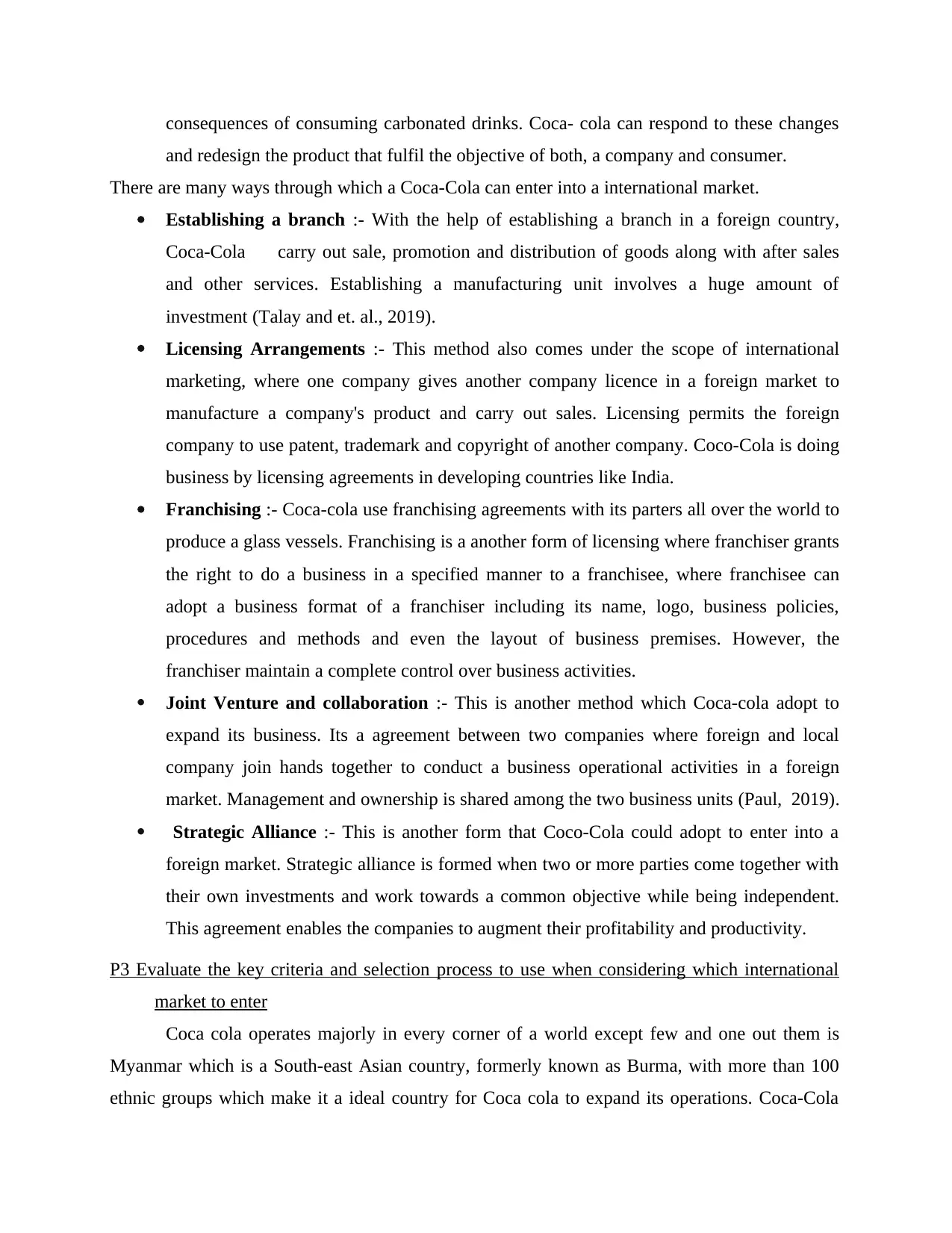
consequences of consuming carbonated drinks. Coca- cola can respond to these changes
and redesign the product that fulfil the objective of both, a company and consumer.
There are many ways through which a Coca-Cola can enter into a international market.
Establishing a branch :- With the help of establishing a branch in a foreign country,
Coca-Cola carry out sale, promotion and distribution of goods along with after sales
and other services. Establishing a manufacturing unit involves a huge amount of
investment (Talay and et. al., 2019).
Licensing Arrangements :- This method also comes under the scope of international
marketing, where one company gives another company licence in a foreign market to
manufacture a company's product and carry out sales. Licensing permits the foreign
company to use patent, trademark and copyright of another company. Coco-Cola is doing
business by licensing agreements in developing countries like India.
Franchising :- Coca-cola use franchising agreements with its parters all over the world to
produce a glass vessels. Franchising is a another form of licensing where franchiser grants
the right to do a business in a specified manner to a franchisee, where franchisee can
adopt a business format of a franchiser including its name, logo, business policies,
procedures and methods and even the layout of business premises. However, the
franchiser maintain a complete control over business activities.
Joint Venture and collaboration :- This is another method which Coca-cola adopt to
expand its business. Its a agreement between two companies where foreign and local
company join hands together to conduct a business operational activities in a foreign
market. Management and ownership is shared among the two business units (Paul, 2019).
Strategic Alliance :- This is another form that Coco-Cola could adopt to enter into a
foreign market. Strategic alliance is formed when two or more parties come together with
their own investments and work towards a common objective while being independent.
This agreement enables the companies to augment their profitability and productivity.
P3 Evaluate the key criteria and selection process to use when considering which international
market to enter
Coca cola operates majorly in every corner of a world except few and one out them is
Myanmar which is a South-east Asian country, formerly known as Burma, with more than 100
ethnic groups which make it a ideal country for Coca cola to expand its operations. Coca-Cola
and redesign the product that fulfil the objective of both, a company and consumer.
There are many ways through which a Coca-Cola can enter into a international market.
Establishing a branch :- With the help of establishing a branch in a foreign country,
Coca-Cola carry out sale, promotion and distribution of goods along with after sales
and other services. Establishing a manufacturing unit involves a huge amount of
investment (Talay and et. al., 2019).
Licensing Arrangements :- This method also comes under the scope of international
marketing, where one company gives another company licence in a foreign market to
manufacture a company's product and carry out sales. Licensing permits the foreign
company to use patent, trademark and copyright of another company. Coco-Cola is doing
business by licensing agreements in developing countries like India.
Franchising :- Coca-cola use franchising agreements with its parters all over the world to
produce a glass vessels. Franchising is a another form of licensing where franchiser grants
the right to do a business in a specified manner to a franchisee, where franchisee can
adopt a business format of a franchiser including its name, logo, business policies,
procedures and methods and even the layout of business premises. However, the
franchiser maintain a complete control over business activities.
Joint Venture and collaboration :- This is another method which Coca-cola adopt to
expand its business. Its a agreement between two companies where foreign and local
company join hands together to conduct a business operational activities in a foreign
market. Management and ownership is shared among the two business units (Paul, 2019).
Strategic Alliance :- This is another form that Coco-Cola could adopt to enter into a
foreign market. Strategic alliance is formed when two or more parties come together with
their own investments and work towards a common objective while being independent.
This agreement enables the companies to augment their profitability and productivity.
P3 Evaluate the key criteria and selection process to use when considering which international
market to enter
Coca cola operates majorly in every corner of a world except few and one out them is
Myanmar which is a South-east Asian country, formerly known as Burma, with more than 100
ethnic groups which make it a ideal country for Coca cola to expand its operations. Coca-Cola

aims at each level crafting a unique brand image in the world which offers a carbonated soft
drinks to each part of world. Coca-Cola is now heading towards the country with an objective of
making profit and capturing a market share of Myanmar.
International market selection process
Objective : Before selecting a target market it is essential to analyse what is the long
term short term objective of a company. In the context of Coca-Cola, the objective of
company is to enter into the market which is new and unexplored (Kozlenkova and et.
al., 2021).
Parameters for selection : After deciding a objective of a company next step comes at
evaluation of business plan at different basis like availability of raw materials and
workforce, nature and type of target market, government policies, etc.
Preliminary Screening : The core objective of this step is to eliminate the markets
which are not potential and opt for the one that would generate a better results.
Preliminary screening is done on the basis of size of population, availability of
disposable income and economic stability
Evaluation and selection :- After selecting a potential market the next step is evaluating
the market taking in account company's own financial & other resources and external
market.
Test Marketing and Commercial production : At this last step Coca-Cola launch a
product on smaller scale to check the feasibility of market and according to the results
Coca-Cola further plan to operate at large scale.
P4 Explain using different examples, the different marketing strategies including the advantage
and disadvantage of each
There are various ways by which a Coca-Cola can enter into a foreign market. Entering
into a foreign market required a legal proceedings which sometime is difficult to follow and
adopt(Asseraf and Shoham, 2019). The ways of entering into a foreign market vary with the
nature and type of business, risk and cost associated with business and a degree of control
company may have.
Exporting :- This approach is beneficial for Coca-cola while entering into a foreign
market, where Coco-Cola does not operate. This allows company to sell their products in
drinks to each part of world. Coca-Cola is now heading towards the country with an objective of
making profit and capturing a market share of Myanmar.
International market selection process
Objective : Before selecting a target market it is essential to analyse what is the long
term short term objective of a company. In the context of Coca-Cola, the objective of
company is to enter into the market which is new and unexplored (Kozlenkova and et.
al., 2021).
Parameters for selection : After deciding a objective of a company next step comes at
evaluation of business plan at different basis like availability of raw materials and
workforce, nature and type of target market, government policies, etc.
Preliminary Screening : The core objective of this step is to eliminate the markets
which are not potential and opt for the one that would generate a better results.
Preliminary screening is done on the basis of size of population, availability of
disposable income and economic stability
Evaluation and selection :- After selecting a potential market the next step is evaluating
the market taking in account company's own financial & other resources and external
market.
Test Marketing and Commercial production : At this last step Coca-Cola launch a
product on smaller scale to check the feasibility of market and according to the results
Coca-Cola further plan to operate at large scale.
P4 Explain using different examples, the different marketing strategies including the advantage
and disadvantage of each
There are various ways by which a Coca-Cola can enter into a foreign market. Entering
into a foreign market required a legal proceedings which sometime is difficult to follow and
adopt(Asseraf and Shoham, 2019). The ways of entering into a foreign market vary with the
nature and type of business, risk and cost associated with business and a degree of control
company may have.
Exporting :- This approach is beneficial for Coca-cola while entering into a foreign
market, where Coco-Cola does not operate. This allows company to sell their products in
⊘ This is a preview!⊘
Do you want full access?
Subscribe today to unlock all pages.

Trusted by 1+ million students worldwide

overseas market through agents and distributors. Exporting a products incurs a less cost as
compared to starting the operation from zero level.
Advantages of Exporting
Exporting provides a competitive advantage to the company as exporting allows a better
exposure to the products or ideas.
Capturing a large market share in overseas market can increase the sales volume of Coca-
Cola.
Catering to the needs of foreign customer through exporting results in increase in profit of
a company as the orders are placed generally at high level as compared to local
market(Westjohn and Magnusson, 2019).
Disadvantage of Exporting
Complying with the norms and regulations of exports of a foreign country is challenging
task. Change in a exchange rate and foreign exchange policy can also threaten the export
approach of Coca-Cola.
Product modification :- To export a product, Coca-Cola must meet some safety, security
and other requirements which may turn out to be product modification which may give
rise to unexpected cost.
Licensing :- Coca-Cola can also opt for a Licensing where a one company enters into an
agreement with another company to use the patents, trademarks and copyrights of
company who grants licensing. This approach is ideal where the company at local market
holds certainly large market share.
Advantages of Licensing
Entering into the foreign market through licensing is the most easy and convenient way,
which involves less amount of cost and risk.
Licensing could result in generate a extra income for a company. Licensing permits a
another company to use its patents, trademarks and copyright with a certain amount of fee
involved(Ferraris and et. al., 2019).
Disadvantage of Licensing
Granting an authority to use companies intellectual properties may give rise to the theft
and misuse which may have a negative impact on the brand image of a company.
compared to starting the operation from zero level.
Advantages of Exporting
Exporting provides a competitive advantage to the company as exporting allows a better
exposure to the products or ideas.
Capturing a large market share in overseas market can increase the sales volume of Coca-
Cola.
Catering to the needs of foreign customer through exporting results in increase in profit of
a company as the orders are placed generally at high level as compared to local
market(Westjohn and Magnusson, 2019).
Disadvantage of Exporting
Complying with the norms and regulations of exports of a foreign country is challenging
task. Change in a exchange rate and foreign exchange policy can also threaten the export
approach of Coca-Cola.
Product modification :- To export a product, Coca-Cola must meet some safety, security
and other requirements which may turn out to be product modification which may give
rise to unexpected cost.
Licensing :- Coca-Cola can also opt for a Licensing where a one company enters into an
agreement with another company to use the patents, trademarks and copyrights of
company who grants licensing. This approach is ideal where the company at local market
holds certainly large market share.
Advantages of Licensing
Entering into the foreign market through licensing is the most easy and convenient way,
which involves less amount of cost and risk.
Licensing could result in generate a extra income for a company. Licensing permits a
another company to use its patents, trademarks and copyright with a certain amount of fee
involved(Ferraris and et. al., 2019).
Disadvantage of Licensing
Granting an authority to use companies intellectual properties may give rise to the theft
and misuse which may have a negative impact on the brand image of a company.
Paraphrase This Document
Need a fresh take? Get an instant paraphrase of this document with our AI Paraphraser
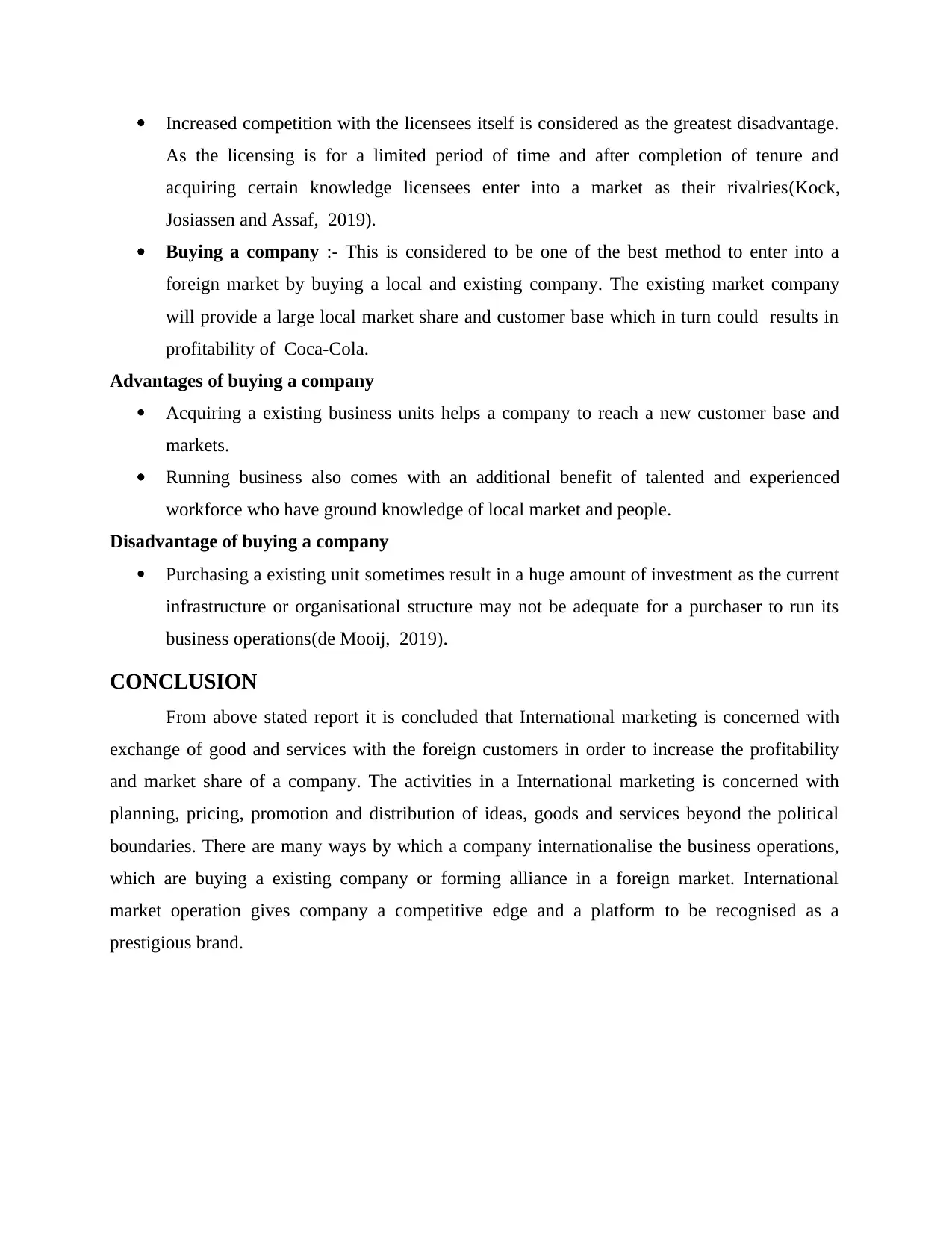
Increased competition with the licensees itself is considered as the greatest disadvantage.
As the licensing is for a limited period of time and after completion of tenure and
acquiring certain knowledge licensees enter into a market as their rivalries(Kock,
Josiassen and Assaf, 2019).
Buying a company :- This is considered to be one of the best method to enter into a
foreign market by buying a local and existing company. The existing market company
will provide a large local market share and customer base which in turn could results in
profitability of Coca-Cola.
Advantages of buying a company
Acquiring a existing business units helps a company to reach a new customer base and
markets.
Running business also comes with an additional benefit of talented and experienced
workforce who have ground knowledge of local market and people.
Disadvantage of buying a company
Purchasing a existing unit sometimes result in a huge amount of investment as the current
infrastructure or organisational structure may not be adequate for a purchaser to run its
business operations(de Mooij, 2019).
CONCLUSION
From above stated report it is concluded that International marketing is concerned with
exchange of good and services with the foreign customers in order to increase the profitability
and market share of a company. The activities in a International marketing is concerned with
planning, pricing, promotion and distribution of ideas, goods and services beyond the political
boundaries. There are many ways by which a company internationalise the business operations,
which are buying a existing company or forming alliance in a foreign market. International
market operation gives company a competitive edge and a platform to be recognised as a
prestigious brand.
As the licensing is for a limited period of time and after completion of tenure and
acquiring certain knowledge licensees enter into a market as their rivalries(Kock,
Josiassen and Assaf, 2019).
Buying a company :- This is considered to be one of the best method to enter into a
foreign market by buying a local and existing company. The existing market company
will provide a large local market share and customer base which in turn could results in
profitability of Coca-Cola.
Advantages of buying a company
Acquiring a existing business units helps a company to reach a new customer base and
markets.
Running business also comes with an additional benefit of talented and experienced
workforce who have ground knowledge of local market and people.
Disadvantage of buying a company
Purchasing a existing unit sometimes result in a huge amount of investment as the current
infrastructure or organisational structure may not be adequate for a purchaser to run its
business operations(de Mooij, 2019).
CONCLUSION
From above stated report it is concluded that International marketing is concerned with
exchange of good and services with the foreign customers in order to increase the profitability
and market share of a company. The activities in a International marketing is concerned with
planning, pricing, promotion and distribution of ideas, goods and services beyond the political
boundaries. There are many ways by which a company internationalise the business operations,
which are buying a existing company or forming alliance in a foreign market. International
market operation gives company a competitive edge and a platform to be recognised as a
prestigious brand.

References:
Books and Journals
Asseraf, Y. and Shoham, A., 2019. Crafting strategy for international marketing: outside-in or
inside-out?. International Marketing Review.
de Mooij, M., 2019. Fairy tales of global consumer culture in a polarizing world. International
Marketing Review.
Eng and et. al., 2020. International social entrepreneurship and social value creation in cause-
related marketing through personal relationships and accountability. International
Marketing Review.
Ferraris and et. al., 2019. Refining the relation between cause-related marketing and consumers
purchase intentions: a cross-country analysis. International Marketing Review.
Gnizy, I., 2019. Big data and its strategic path to value in international firms. International
Marketing Review.
Kock, F., Josiassen, A. and Assaf, A.G., 2019. Toward a universal account of country-induced
predispositions: integrative framework and measurement of country-of-origin images
and country emotions. Journal of International Marketing. 27(3). pp.43-59.
Kozlenkova and et. al., 2021. Sharing economy: International marketing strategies. Journal of
International Business Studies, pp.1-29.
Martin, S.L., Javalgi, R.R.G. and Ciravegna, L., 2020. Marketing capabilities and international
new venture performance: The mediation role of marketing communication and the
moderation effect of technological turbulence. Journal of Business Research. 107.
pp.25-37.
Paul, J., 2019. Marketing in emerging markets: a review, theoretical synthesis and
extension. International Journal of Emerging Markets.
Talay and et. al., 2019. Stock Market Reactions to New Product Launches in International
Markets: The Moderating Role of Culture. Journal of International Marketing. 27(4).
pp.81-98.
Westjohn, S.A. and Magnusson, P., 2019. Conceptualizing and operationalizing local and global
cultural identities: a comment. International marketing review.
Books and Journals
Asseraf, Y. and Shoham, A., 2019. Crafting strategy for international marketing: outside-in or
inside-out?. International Marketing Review.
de Mooij, M., 2019. Fairy tales of global consumer culture in a polarizing world. International
Marketing Review.
Eng and et. al., 2020. International social entrepreneurship and social value creation in cause-
related marketing through personal relationships and accountability. International
Marketing Review.
Ferraris and et. al., 2019. Refining the relation between cause-related marketing and consumers
purchase intentions: a cross-country analysis. International Marketing Review.
Gnizy, I., 2019. Big data and its strategic path to value in international firms. International
Marketing Review.
Kock, F., Josiassen, A. and Assaf, A.G., 2019. Toward a universal account of country-induced
predispositions: integrative framework and measurement of country-of-origin images
and country emotions. Journal of International Marketing. 27(3). pp.43-59.
Kozlenkova and et. al., 2021. Sharing economy: International marketing strategies. Journal of
International Business Studies, pp.1-29.
Martin, S.L., Javalgi, R.R.G. and Ciravegna, L., 2020. Marketing capabilities and international
new venture performance: The mediation role of marketing communication and the
moderation effect of technological turbulence. Journal of Business Research. 107.
pp.25-37.
Paul, J., 2019. Marketing in emerging markets: a review, theoretical synthesis and
extension. International Journal of Emerging Markets.
Talay and et. al., 2019. Stock Market Reactions to New Product Launches in International
Markets: The Moderating Role of Culture. Journal of International Marketing. 27(4).
pp.81-98.
Westjohn, S.A. and Magnusson, P., 2019. Conceptualizing and operationalizing local and global
cultural identities: a comment. International marketing review.
⊘ This is a preview!⊘
Do you want full access?
Subscribe today to unlock all pages.

Trusted by 1+ million students worldwide
1 out of 9
Related Documents
Your All-in-One AI-Powered Toolkit for Academic Success.
+13062052269
info@desklib.com
Available 24*7 on WhatsApp / Email
![[object Object]](/_next/static/media/star-bottom.7253800d.svg)
Unlock your academic potential
Copyright © 2020–2025 A2Z Services. All Rights Reserved. Developed and managed by ZUCOL.



